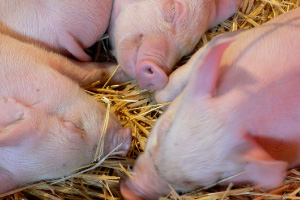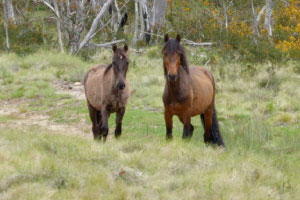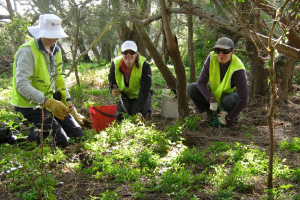
State updates – August 2015
Want a quick wrap-up of invasive species issues across Australia? Then check out our new State Updates.

Want a quick wrap-up of invasive species issues across Australia? Then check out our new State Updates.

A concerned supporter sent us this email exchange after seeing privet hedges featured at a private garden and function centre on the NSW South Coast.

Three months out from a state election NSW environment minister Rob Stokes has ruled out using the only option left to prevent growing feral horse numbers in Kosciuszko National Park – aerial shooting.

A colony of red imported fire ants was discovered in Sydney early December. If they are not eradicated, life in Australia will be irrevocably changed.

Five years worth of efforts in improving NSW invasive species laws came excruciatingly close to reality. In the end the Bill failed to pass Parliament.

The NSW primary industries minister threatened to use biosecurity laws to prosecute animal activists. Animal activists just as much as farmers and other members of the community need to use good biosecurity practices.

As feral horse numbers grow in the Australian Alps in the absence of an effective control program, so too is concern about the escalating damage.

Environment groups have praised the NSW Government’s new biosecurity framework as a tool for modernising the state’s approach to weeds, pests and feral animals but want more detail on how it will tackle the impacts of these threats on the environment.

When you spend your life watching your favourite bushland spots being invaded and overrun by weeds nothing is more infuriating than seeing local nurseries selling those same weeds to an unsuspecting public.

Use this submission guide to help change the way weeds are managed in NSW. Comments to the Natural Resources Commission draft report on weed management are due Sunday 6 April 2014.

Meetings will be held during March 2014 in seven locations throughout NSW to hear about the Natural Resources Commission’s draft report on weed management.
In October the NSW Parliament passed legislation abolishing the NSW Game Council in response to the backlash against the proposal for recreational hunting in national
The Invasive Species Council today urged the NSW Government to amend the Bill abolishing Game Council NSW, introduced into Parliament today, to overcome the game hunting culture that is hampering feral animal control in that state.

The abolition of the NSW Game Council from July 2013 was a watershed in the way the NSW Government deals with recreational hunting. But is

The abolition of the NSW Game Council from July 2013 was a watershed in the way the NSW Government deals with recreational hunting. But is

Want a quick wrap-up of invasive species issues across Australia? Then check out our new State Updates.

A concerned supporter sent us this email exchange after seeing privet hedges featured at a private garden and function centre on the NSW South Coast.

Three months out from a state election NSW environment minister Rob Stokes has ruled out using the only option left to prevent growing feral horse numbers in Kosciuszko National Park – aerial shooting.

A colony of red imported fire ants was discovered in Sydney early December. If they are not eradicated, life in Australia will be irrevocably changed.

Five years worth of efforts in improving NSW invasive species laws came excruciatingly close to reality. In the end the Bill failed to pass Parliament.

The NSW primary industries minister threatened to use biosecurity laws to prosecute animal activists. Animal activists just as much as farmers and other members of the community need to use good biosecurity practices.

As feral horse numbers grow in the Australian Alps in the absence of an effective control program, so too is concern about the escalating damage.

Environment groups have praised the NSW Government’s new biosecurity framework as a tool for modernising the state’s approach to weeds, pests and feral animals but want more detail on how it will tackle the impacts of these threats on the environment.

When you spend your life watching your favourite bushland spots being invaded and overrun by weeds nothing is more infuriating than seeing local nurseries selling those same weeds to an unsuspecting public.

Use this submission guide to help change the way weeds are managed in NSW. Comments to the Natural Resources Commission draft report on weed management are due Sunday 6 April 2014.

Meetings will be held during March 2014 in seven locations throughout NSW to hear about the Natural Resources Commission’s draft report on weed management.
In October the NSW Parliament passed legislation abolishing the NSW Game Council in response to the backlash against the proposal for recreational hunting in national
The Invasive Species Council today urged the NSW Government to amend the Bill abolishing Game Council NSW, introduced into Parliament today, to overcome the game hunting culture that is hampering feral animal control in that state.

The abolition of the NSW Game Council from July 2013 was a watershed in the way the NSW Government deals with recreational hunting. But is

The abolition of the NSW Game Council from July 2013 was a watershed in the way the NSW Government deals with recreational hunting. But is

Want a quick wrap-up of invasive species issues across Australia? Then check out our new State Updates.

A concerned supporter sent us this email exchange after seeing privet hedges featured at a private garden and function centre on the NSW South Coast.

Three months out from a state election NSW environment minister Rob Stokes has ruled out using the only option left to prevent growing feral horse numbers in Kosciuszko National Park – aerial shooting.

A colony of red imported fire ants was discovered in Sydney early December. If they are not eradicated, life in Australia will be irrevocably changed.

Five years worth of efforts in improving NSW invasive species laws came excruciatingly close to reality. In the end the Bill failed to pass Parliament.

The NSW primary industries minister threatened to use biosecurity laws to prosecute animal activists. Animal activists just as much as farmers and other members of the community need to use good biosecurity practices.

As feral horse numbers grow in the Australian Alps in the absence of an effective control program, so too is concern about the escalating damage.

Environment groups have praised the NSW Government’s new biosecurity framework as a tool for modernising the state’s approach to weeds, pests and feral animals but want more detail on how it will tackle the impacts of these threats on the environment.

When you spend your life watching your favourite bushland spots being invaded and overrun by weeds nothing is more infuriating than seeing local nurseries selling those same weeds to an unsuspecting public.

Use this submission guide to help change the way weeds are managed in NSW. Comments to the Natural Resources Commission draft report on weed management are due Sunday 6 April 2014.

Meetings will be held during March 2014 in seven locations throughout NSW to hear about the Natural Resources Commission’s draft report on weed management.
In October the NSW Parliament passed legislation abolishing the NSW Game Council in response to the backlash against the proposal for recreational hunting in national
The Invasive Species Council today urged the NSW Government to amend the Bill abolishing Game Council NSW, introduced into Parliament today, to overcome the game hunting culture that is hampering feral animal control in that state.

The abolition of the NSW Game Council from July 2013 was a watershed in the way the NSW Government deals with recreational hunting. But is

The abolition of the NSW Game Council from July 2013 was a watershed in the way the NSW Government deals with recreational hunting. But is
Get our blog the Feral Herald delivered to your inbox.
Our protected areas are being trashed, trampled, choked and polluted by an onslaught of invaders. Invasive species are already the overwhelming driver of our animal extinction rate, and are expected to cause 75 of the next 100 extinctions.
But you can help to turn this around and create a wildlife revival in Australia.
From numbats to night parrots, a tax-deductible donation today can help defend our wildlife against the threat of invasive weeds, predators, and diseases.
As the only national advocacy environment group dedicated to stopping this mega threat, your gift will make a big difference.
A silent crisis is unfolding across Australia. Every year, billions of native animals are hunted and killed by cats and foxes. Fire ants continue to spread and threaten human health. And the deadly strain of bird flu looms on the horizon. Your donation today will be used to put the invasive species threat in the media, make invasive species a government priority, ensure governments take rapid action to protect nature and our remarkable native wildlife from invasives-led extinction, death and destruction.
If you are having trouble submitting a form, please read this guide.
Please fill out the following form and one of our team will be in contact to assist as soon as possible. Please make sure to include any helpful information, such as the device you were using (computer, tablet or mobile phone) and if known, your browser (Mozilla Firefox, Chrome, Safari etc)
"*" indicates required fields
Dear Project Team,
[YOUR PERSONALISED MESSAGE WILL APPEAR HERE.]
I support the amendment to the Kosciuszko National Park Wild Horse Heritage Management Plan to allow our incredible National Parks staff to use aerial shooting as one method to rapidly reduce feral horse numbers. I want to see feral horse numbers urgently reduced in order to save the national park and our native wildlife that live there.
The current approach is not solving the problem. Feral horse numbers have rapidly increased in Kosciuszko National Park to around 18,000, a 30% jump in just the past 2 years. With the population so high, thousands of feral horses need to be removed annually to reduce numbers and stop our National Park becoming a horse paddock. Aerial shooting, undertaken humanely and safely by professionals using standard protocols, is the only way this can happen.
The government’s own management plan for feral horses states that ‘if undertaken in accordance with best practice, aerial shooting can have the lowest negative animal welfare impacts of all lethal control methods’.
This humane and effective practice is already used across Australia to manage hundreds of thousands of feral animals like horses, deer, pigs, and goats.
Trapping and rehoming of feral horses has been used in Kosciuszko National Park for well over a decade but has consistently failed to reduce the population, has delayed meaningful action and is expensive. There are too many feral horses in the Alps and not enough demand for rehoming for it to be relied upon for the reduction of the population.
Fertility control as a management tool is only effective for a small, geographically isolated, and accessible population of feral horses where the management outcome sought is to maintain the population at its current size. It is not a viable option to reduce the large and growing feral horse population in the vast and rugged terrain of Kosciuszko National Park.
Feral horses are trashing and trampling our sensitive alpine ecosystems and streams, causing the decline and extinction of native animals. The federal government’s Threatened Species Scientific Committee has stated that feral horses ‘may be the crucial factor that causes final extinction’ for 12 alpine species.
I recognise the sad reality that urgent and humane measures are necessary to urgently remove the horses or they will destroy the Snowies and the native wildlife that call the mountains home. I support a healthy national park where native species like the Corroboree Frog and Mountain Pygmy Possum can thrive.
Dear Project Team,
[YOUR PERSONALISED MESSAGE WILL APPEAR HERE.]
I support the amendment to the Kosciuszko National Park Wild Horse Heritage Management Plan to allow our incredible National Parks staff to use aerial shooting as one method to rapidly reduce feral horse numbers. I want to see feral horse numbers urgently reduced in order to save the national park and our native wildlife that live there.
The current approach is not solving the problem. Feral horse numbers have rapidly increased in Kosciuszko National Park to around 18,000, a 30% jump in just the past 2 years. With the population so high, thousands of feral horses need to be removed annually to reduce numbers and stop our National Park becoming a horse paddock. Aerial shooting, undertaken humanely and safely by professionals using standard protocols, is the only way this can happen.
The government’s own management plan for feral horses states that ‘if undertaken in accordance with best practice, aerial shooting can have the lowest negative animal welfare impacts of all lethal control methods’.
This humane and effective practice is already used across Australia to manage hundreds of thousands of feral animals like horses, deer, pigs, and goats.
Trapping and rehoming of feral horses has been used in Kosciuszko National Park for well over a decade but has consistently failed to reduce the population, has delayed meaningful action and is expensive. There are too many feral horses in the Alps and not enough demand for rehoming for it to be relied upon for the reduction of the population.
Fertility control as a management tool is only effective for a small, geographically isolated, and accessible population of feral horses where the management outcome sought is to maintain the population at its current size. It is not a viable option to reduce the large and growing feral horse population in the vast and rugged terrain of Kosciuszko National Park.
Feral horses are trashing and trampling our sensitive alpine ecosystems and streams, causing the decline and extinction of native animals. The federal government’s Threatened Species Scientific Committee has stated that feral horses ‘may be the crucial factor that causes final extinction’ for 12 alpine species.
I recognise the sad reality that urgent and humane measures are necessary to urgently remove the horses or they will destroy the Snowies and the native wildlife that call the mountains home. I support a healthy national park where native species like the Corroboree Frog and Mountain Pygmy Possum can thrive.